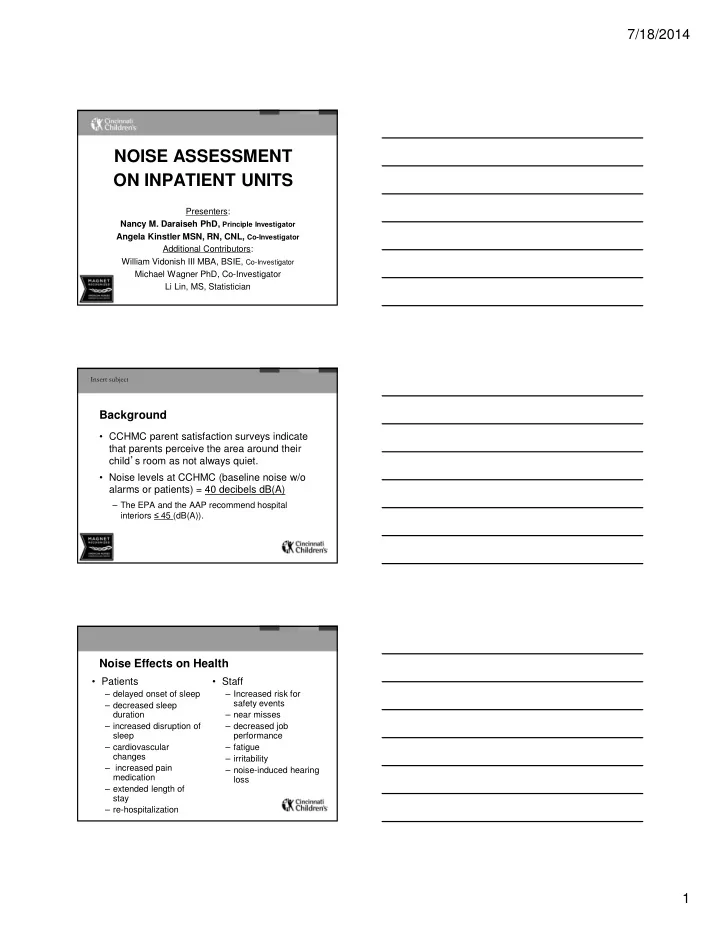

7/18/2014 NOISE ASSESSMENT ON INPATIENT UNITS Presenters: Nancy M. Daraiseh PhD, Principle Investigator Angela Kinstler MSN, RN, CNL, Co-Investigator Additional Contributors: William Vidonish III MBA, BSIE, Co-Investigator Michael Wagner PhD, Co-Investigator Li Lin, MS, Statistician �������������� Background • CCHMC parent satisfaction surveys indicate that parents perceive the area around their child ’ s room as not always quiet. • Noise levels at CCHMC (baseline noise w/o alarms or patients) = 40 decibels dB(A) – The EPA and the AAP recommend hospital interiors � 45 (dB(A)). Noise Effects on Health • Patients • Staff – delayed onset of sleep – Increased risk for safety events – decreased sleep duration – near misses – increased disruption of – decreased job sleep performance – cardiovascular – fatigue changes – irritability – increased pain – noise-induced hearing medication loss – extended length of stay – re-hospitalization 1
7/18/2014 Objective: • Describe recommended noise levels in the healthcare environment and impact of noise on staff health.. Magnet Components • New Knowledge, innovations & improvements • Exemplary Professional Practice Overall goal: • By prospectively measuring noise exposure on inpatient units we can identify: – major sources of noise – levels of noise exposure – associations with health indicators • These are important steps to developing and implementing practice changes that can reduce the occupational burden of noise on inpatient units for patients, families & staff. 2
7/18/2014 Specific Aims 1. Determine the prevalence of excessive occupational noise exposure (decibel, duration) on inpatient units (provider & patient). 2. Determine worker, patient, and environmental characteristics that contribute to excessive occupational noise exposures on inpatient units. What is involved? • Phase I – The focus is to involve members from each unit to form a core team to develop the research plan for this study. – This team was responsible for oversight of the study and recruitment on their respective units. What is involved? • Phase II – The study involves measuring levels and sources of noise on all inpatient units using dosimeters worn by staff and attached to patient beds – Six, 4-hour shifts for each unit – Observers log sources of noise at 5-minute intervals – Staff wear heart rate monitors to assess health impact – Student observers carried out data collection 3
7/18/2014 ���������������������� � ������������������� � ���������������������� � ���������������������������������� � ������ � �������������������� � ���������� � ������������������������������������������� RESULTS Demographics • 19 Units including Base, Liberty & College Hill • 5 non-participating units • Demographics: – Total 89 nurses*, 88.8% female – Average age = 36 ± ± 9.8 (Range 23-63) ± ± – Average experience = 8.1 ± ± 7.9 years (Range 0-37) ± ± – Average BMI = 27.4 ± ± 5.7 (Range 19-41) ± ± *7 nurses repeated observations 4
7/18/2014 Descriptive Data • 19804 noise observations • 16535 heart rate (HR) data points • Baseline HR 89.9 ± 9.2 (40-191) • Stress (0-100) – Pre 26.7 ± 26.1 – 2hr 28.3 ± 26.3 – Post 20.4 ± 24.3 Noise exposure at the staff level • The average observed noise level was 76dB ± 9.2 (45-111). • The average noise level in 10 out of 15 units (66.7%) exceeded the “excessive” noise threshold of 75dB. – Overall: 54% – College Hill: 53.4% – Base: 55.6% *noise levels >90dB occurred at 4.9% of the time 5
7/18/2014 Noise Level Distribution Units with the Highest Noise Levels 84 83.4 83 82 Mean Noise Level (dB) 81 80 79.6 79 78.8 79 78.7 78 77 76 P3S A6S A6C P3N B5CA Sources of Noise 6
7/18/2014 Sources of Noise Defined as “Other” • In descending order – General ambient noise when no other sound was present (e.g. air conditioning) – Office equipment (fax/copier/printer) – Keyboard strokes or clicking of the mouse – Things falling on the floor – Running faucet or flushing toilet – Sneezing – Music – Running sink – Trash can (throwing away items, kicking, etc.) – Chest tube drainage systems – Chairs scooting across the floor Noise Location Activity 7
7/18/2014 Noise Sources > 75dB Noise Location > 75dB Activity when noise > 75dB 8
7/18/2014 Heart Rate Distribution 10.0 - 40.0 40.0 - 70.0 70.0 - 100.0 100.0 - 130.0 130.0 - 160.0 160.0 - 190.0 190.0 - 220.0 220.0 - 250.0 250.0 - 280.0 Heart Rate Units with the Highest Average Heart Rate 98 97.3 96 95.5 94 92.2 Average Heart Rate 92 91.4 90 88.1 88 86 84 82 A7C1 B4 A6C A3S B5CA Noise & HR All nurses • The average heart rate increased 0.8% when noise levels >75dB. • The average heart rate increased 2.4% when noise levels >90dB. Nurses with baseline heart rate � 100 • 10.1% of nurses’ HR was >100 • The average heart rate increased 1.0% when noise levels >75dB. • The average heart rate increased 2.5% when noise levels >90dB. 9
7/18/2014 Noise level comparison between nurses and patients • The mean patient’s noise level 63.6dB was significantly lower than the mean nurses’ noise level 76dB. Conclusions • Staff on inpatient units are exposed to high noise levels over 50% of the time • Many sources of noise are preventable (i.e. Staff conversations) • Noise levels have a significant association w/ HR but not on self-reported stress and tachycardia • Recommendations of 45dBA may be unattainable in some settings Limitations • Baseline HR • Sources of noise not unit-specific • Number of shifts assessed per unit – noise & shift – noise & time of day • Lack of patient variables • Subjectivity in documentation 10
7/18/2014 Next Steps • Units have the area-specific data to begin quality improvement projects that can reduce overall noise to acceptable levels • Unit-specific assessments can allow for in- depth understanding of noise sources • Incorporating patient-specific data and/or outcomes in noise assessments Questions? 11
Recommend
More recommend